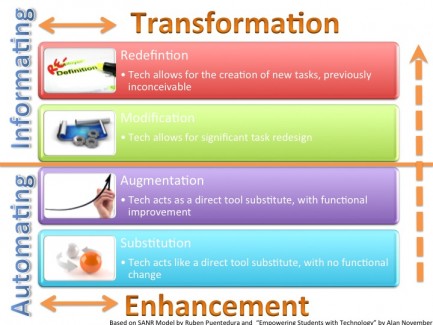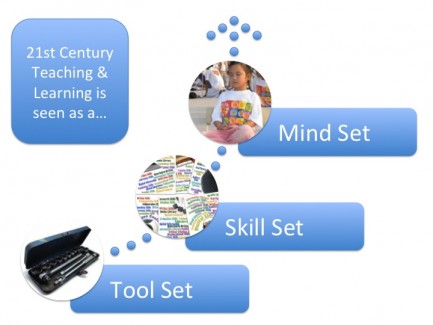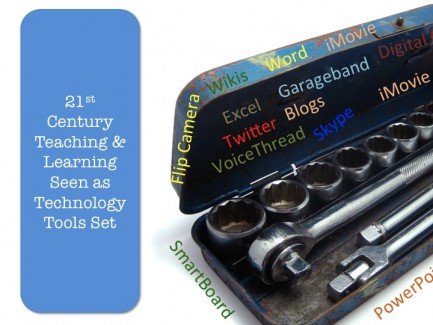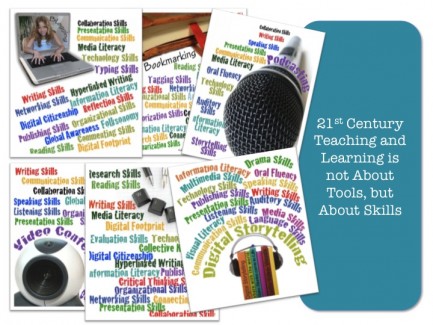A Timeline: Tool Set - Skill Set - Mind Set

In my previous post titled Enhancement-Automating-Transforming-Informating, I described the fusion (in my mind) of the SAMR model with Alan November's concept of Automating vs. Informating to transform teaching and learning. Since then, my colleague Andrea Hernandez and I have set down to create a visual using the above model to include concrete examples from our school to illustrate to our teachers what tasks are considered in the substitution/augmentation/modification/redefinition stages. We want to be transparent in showing our expectations of basic tasks being led autonomously by the classroom teachers to teach and support students without the necessity of tech support to be present. At the same time, we wanted to emphasize the progression and show what transformational teaching and learning looks like. As we were populating the chart, it became clear to me that the stages were part of a time line, a process that an individual and an entire school cultures had to go through in order to transform and leap from "preparing students for 1970s, 1980's 1990's to preparing them for 2020's and beyond" (Heidi Hayes Jacobs). Once I saw the imaginary time line, I also felt that that the stages coincided with how (21st century) teaching and learning was seen. We used to see it as a: Tools Set:

- we taught keyboarding classes
- we had classes that taught a specific version of a office program (Word, Excel, PowerPoint)
- we emphasized file management
- we supported teachers when they did not know which button to click for printing
- we gave instructions, such as "click in the upper left corner for the drop down menu and save", we gave new instructions when the software package, platform or version changed
- we gave tech support to upload, download and resize images
Then we started to understand that it was never about the tools, but about the skills teachers and students would acquire when using these tools. Skill Set:
- we blog to teach and learn about writing, communication, networking, presentation, publishing, commenting, reflection, organization and collaboration skills. Blogging is about Digital Citizenship, Media Literacy, Information Literacy and Global Awareness.
- we use wikis to understand about copyright, evaluation and analysis of Information, collective knowledge and new writing genres.
- we skype in order to expose and connect teachers and students locally and globally to peers, experts, eye witnesses. We become more fluent in networking and and information literacies, speaking, listening and presentation skills are honed.
- we teach bookmarking skills to help teachers and students cope with the exponentially increasing information available. Finding, evaluating, analyzing, tagging, categorizing, organizing, connecting and remixing of information are just some of the skills necessary for that
- we podcast (audio and video) to allow students to express themselves and their knowledge in more than the written form. We incorporate storytelling in order to give students multimedia skills as well as expose them to visual literacy and information literacy.
Now, it seems that teaching and learning will not necessarily move from the "enhancement" to the "transformation" stage with a tool set and the necessary skills alone. In order for teaching and learning to become transformative there also needs to be a Mind Set:
- Our world has flattened and is interconnected
- Information is just going to continue to grow exponentially
- Students of today and tomorrow learn differently than we did
- We are life long learners
- We are self-directed learners
- "How we connect with each other is how learning occurs" (Stephen Wilmarth)
- "The literate of the 21st century will not be those who cannot read or write, but the ones who cannot learn, unlearn and relearn" (Alvin Toffler)
- "Collaboration and sharing knowledge are highly prized skills" (Alan November)
Take a look at the following graphic and keep a time line in mind, as well as the stages mentioned above to move from substitution to redefinition. Does this make sense to you? What would you add?





Tools and ideas to transform education. Sign up below.
